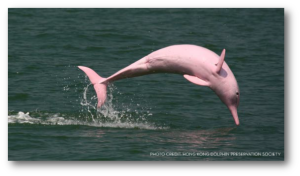By: Claire Kim
Hong Kong is home to a unique species of dolphin known as the Chinese white dolphin–contrary to that name, the species is actually famous for its pink coloring. The dolphins were the official mascots of the ceremonies in which Great Britain formally handed over Hong Kong’s sovereignty to China, and to this day, they are a major tourist attraction that draws thousands to Hong Kong’s western waters each year.
However, this colorful dolphin is under threat of extinction.
The habitat that the pink dolphins live in is slowly shrinking, depriving the species of food and shelter. Samantha Lee, conservation manager of the World Wildlife Fund in Hong Kong (WWF-Hong Kong), explains that this has seriously impacted the number of pink dolphins in the wild.
There are five factors that are causing the decline in the dolphin population: habitat loss from coastal development, water pollution, underwater noise pollution, vessel collision and overfishing. Their natural habitat happens to span across one of the most congested marine traffic areas in the world, which increases the risk of injuries from boat propellers. There are also many new projects that are disrupting the habitat, such as the 21-mile bridge that stretches between Hong Kong, Macau, and Zhuhai that is set to open next year.
The WWF is working on conservation initiatives to help prevent some of these threats to the pink dolphins. To decrease the number of accidents, Lee and the WWF are working on a pilot program that would increase and enhance the dolphin-watching business. It would also install propeller guards on all tour boats to protect the dolphins in case they stray too close to the boats.
But for now, Lee says, Hong Kong needs to change its priorities. Instead of putting development first, the government should make conservation of greatest importance. “In this nice area we can still host this kind of lovely marine mammals,” says Lee, “so this is so important to us in order to try our best to fight for a safe haven for these dolphins.”


